Stressing State Analysis on a Single Tube CFST Arch Under Spatial Loads
Abstract
:1. Introduction
2. Method of Modelling Structural Stressing State
2.1. Modelling of Structural Stresing State
2.2. The Application of Mann–Kendall Criterion
3. Introduction of the Experiment
3.1. Test Setup
3.2. Test Scheme
4. Stressing State Analysis of the Arch Model
4.1. Investigation into the E-F Curve
4.2. Characteristic Investigation into Strains
4.3. Modelling of Stressing State Submodes
5. Stressing State Analysis Based on the Interpolation of Strains
5.1. Interpolation of Strain/Stress Fields by TSI Method
5.2. Analysis on Strain/Stress Fields
5.3. Analysis on Stressing State Submodes for Internal Forces
6. Conclusions
Author Contributions
Funding
Acknowledgments
Conflicts of Interest
References
- Chen, B.C. Recent development and future trends of arch bridges. In Proceedings of the 7th International Conference on Arch Bridges, Trogir-Split, Croatia, 4–6 October 2013. [Google Scholar]
- Jiang, A.Y.; Chen, J.; Jin, W.L. Experimental investigation and design of thin-walled concrete-filled steel tubes subject to bending. Thin-Walled Struct. 2013, 63, 44–50. [Google Scholar] [CrossRef]
- Han, L.H.; Yao, G.H. Influence of concrete compaction on the strength of concrete-filled steel rhs columns. J. Constr. Steel. Res. 2003, 59, 751–767. [Google Scholar] [CrossRef]
- Chen, S.; Zhang, H. Numerical analysis of the axially loaded concrete filled steel tube columns with debonding separation at the steel-concrete interface. Steel Compos. Struct. 2012, 13, 277–293. [Google Scholar] [CrossRef]
- Xiao, C.; Cai, S.; Chen, T.; Xu, C. Experimental study on shear capacity of circular concrete filled steel tubes. Steel Compos. Struct. 2012, 13, 437–449. [Google Scholar] [CrossRef]
- Rovero, L.; Focacci, F.; Stipo, G. Structural behavior of arch models strengthened using fiber-reinforced polymer strips of different lengths. J. Compos. Constr. 2012, 17, 249–258. [Google Scholar] [CrossRef]
- Zheng, J.; Wang, J. Concrete-filled steel tube arch bridges in China. Engineering 2018, 4, 143–155. [Google Scholar] [CrossRef]
- Zeng, D.R.; Wang, T.J. The study on bearing capacity influence for the steel tube deformation in cfst arch bridge. Appl. Mech. Mater. 2012, 178–181, 2236–2239. [Google Scholar] [CrossRef]
- Pi, Y.L.; Liu, C.; Bradford, M.A.; Zhang, S. In-plane strength of concrete-filled steel tubular circular arches. J. Constr. Steel. Res. 2012, 69, 77–94. [Google Scholar] [CrossRef]
- Geng, Y.; Wang, Y.; Ranzi, G.; Wu, X. Time-dependent analysis of long-span, concrete-filled steel tubular arch bridges. J. Bridge Eng. 2013, 19, 04013019. [Google Scholar] [CrossRef]
- Chen, B.C.; Chen, Y.J. Experimental study on mechanic behaviors of concrete-filled steel tubular rib arch under in-plane loads. Eng. Mech. 2000, 23, 99–106. [Google Scholar] [CrossRef]
- Liu, C.; Wang, Y.; Wang, W.; Wu, X. Seismic performance and collapse prevention of concrete-filled thin-walled steel tubular arches. Thin-Walled Struct. 2014, 80, 91–102. [Google Scholar] [CrossRef]
- Wu, X.; Liu, C.; Wang, W.; Wang, Y. In-plane strength and design of fixed concrete-filled steel tubular parabolic arches. J. Bridge Eng. 2015, 20, 04015016. [Google Scholar] [CrossRef]
- Lin, J.Y. Research of Space-load of CFST (single tube) Single-rib Arches. Master Thesis, Fuzhou University, Fuzhou, Fujian, China, 2004. [Google Scholar]
- Chen, B.C.; Wei, J.G.; Lin, J.Y. Experimental study on concrete filled steel tubular (single tube) arch with one rib under spatial loads. Eng. Mech. 2006, 23, 99–106. [Google Scholar] [CrossRef]
- Li, X.H. Research on the out-of-plane stability of CFST Solid Rib Arches. Ph.D. Thesis, Fuzhou University, Fuzhou, Fujian, China, 2011. [Google Scholar]
- Jihua, D.; Fulin, Z.; Ping, T. Study on method for calculating spatial ultimate load of circular cfst arch. J. Build. Struct. 2014, 35, 28–35. [Google Scholar] [CrossRef]
- Wang, Y.; Ye, Z.W.; Wu, Q.X. Out-of-plane buckling strength analysis for typical single tube CFST arch bridge by finite element method. In Proceedings of the 5th International Conference on Civil Engineering and Urban Planning (CEUP2016), Xi’an, China, 23–26 August 2016. [Google Scholar]
- Yang, L.F.; Zheng, J.; Zhang, W.; Ou, W.; Liu, H.J. Self-adaptive approach for analysis of ultimate load bearing capacity of concrete-filled steel tubular arch bridges. China J. Highw. Transp. 2017, 30, 191–199. [Google Scholar]
- Geng, Y.; Ranzi, G.; Wang, Y.T.; Wang, Y.Y. Out-of-plane creep buckling analysis on slender concrete-filled steel tubular arches. J. Constr. Steel Res. 2018, 140, 174–190. [Google Scholar] [CrossRef]
- Gao, J.; Su, J.Z.; Chen, B.C. Experiment on a concrete filled steel tubular arch with corrugated steel webs subjected to spatial loading. Appl. Mech. Mater. 2012, 166–169, 37–42. [Google Scholar] [CrossRef]
- Shi, J.; Yang, K.K.; Zheng, K.K.; Shen, J.Y.; Zhou, G.C.; Huang, Y.X. An investigation into working behavior characteristics of parabolic CFST arches applying structural stressing state theory. J. Civ. Eng. Manag. 2019, 25, 215–227. [Google Scholar] [CrossRef]
- Zhang, Y.; Zhou, G.C.; Xiong, Y.; Rafiq, M.Y. Techniques for predicting cracking pattern of masonry wallet using artificial neural networks and cellular automata. J. Comput. Civil. Eng. 2010, 24, 161–172. [Google Scholar] [CrossRef]
- Huang, Y.; Zhang, Y.; Zhang, M.; Zhou, G. Method for predicting the failure load of masonry wall panels based on generalized strain-energy density. J. Eng. Mech. 2014, 140, 04014061. [Google Scholar] [CrossRef]
- Engels, F. Dialectics of Nature, 7th ed.; International Publishers: New York, NY, USA, 1973. [Google Scholar]
- Bike, H. “Laws, Natural or Scientific”, Oxford Companion to Philosophy; Oxford University Press Publishers: Oxford, England, 1995. [Google Scholar]
- Mann, H.B. Nonparametric tests against trend. Econometrica 1945, 13, 245–259. [Google Scholar] [CrossRef]
- Kendall, M.G.; Jean, D.G. Rank Correlation Methods; Oxford University Press: New York, NY, USA, 1990. [Google Scholar]
- Hirsch, R.M.; Slack, J.R.; Smith, R.A. Techniques of trend analysis for monthly water quality data. Water Resour. Res. 1982, 18, 107–121. [Google Scholar] [CrossRef]
- Shi, J.; Zheng, K.K.; Tan, Y.Q.; Yang, K.K.; Zhou, G.C. Response simulating interpolation methods for expanding experimental data based on numerical shape functions. Comput. Struct. 2019, 218, 1–8. [Google Scholar] [CrossRef]
- Wang, X.C. Finite Element Method; Tsinghua University Press Publishers: Beijing, China, 2003. [Google Scholar]
- Ayers, P.W. Information theory, the shape function, and the hirshfeld atom. Theor. Chem. Acc. 2006, 115, 370–378. [Google Scholar] [CrossRef]
- Padhi, G.S.; Shenoi, R.A.; Moy, S.S.J.; Mccarthy, M.A. Analytic integration of kernel shape function product integrals in the boundary element method. Comput. Struct. 2001, 79, 1325–1333. [Google Scholar] [CrossRef]
- Han, L.H.; Yao, G.H.; Zhao, X.L. Tests and calculations for hollow structural steel (HSS) stub columns filled with self-con-solidating concrete (SCC). J. Constr. Steel Res. 2005, 61, 1241–1269. [Google Scholar] [CrossRef]
- Gilbert, R.L.; Warner, R.F. Tension stiffening in reinforced concrete slabs. J. Struct. Div. 1978, 104, 1885–1900. [Google Scholar] [CrossRef]
- Zhong, S.T. The Concrete-filled Steel Tubular Structures; Tsinghua University Press Publishers: Beijing, China, 2003. [Google Scholar]

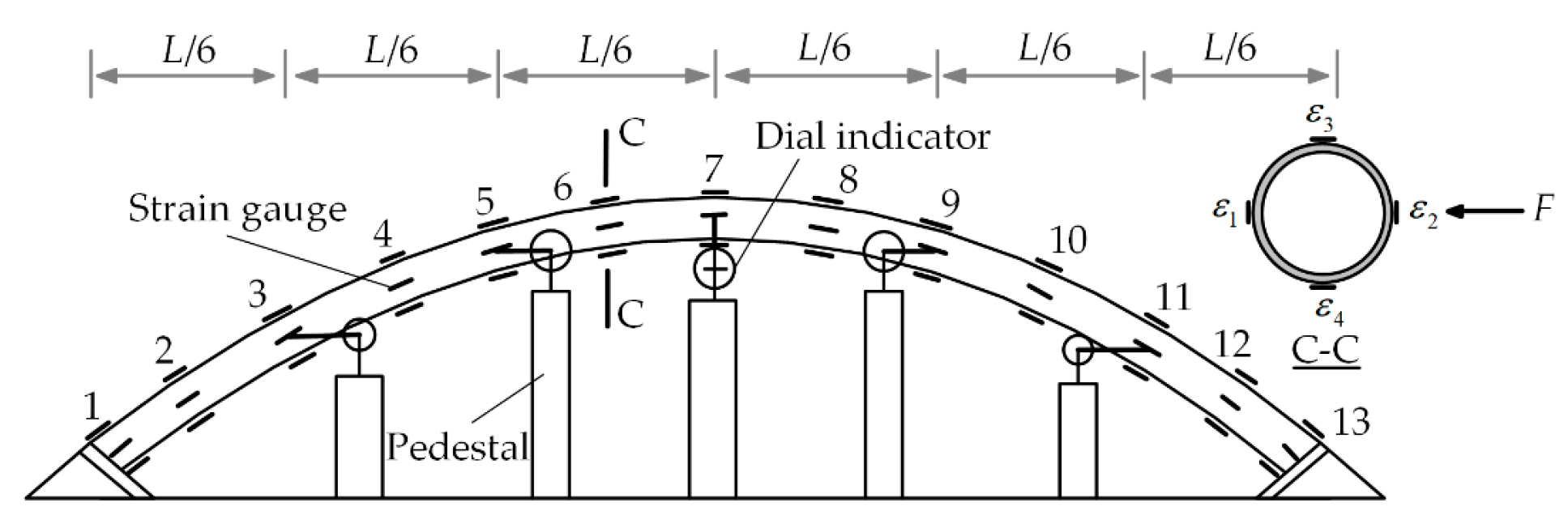


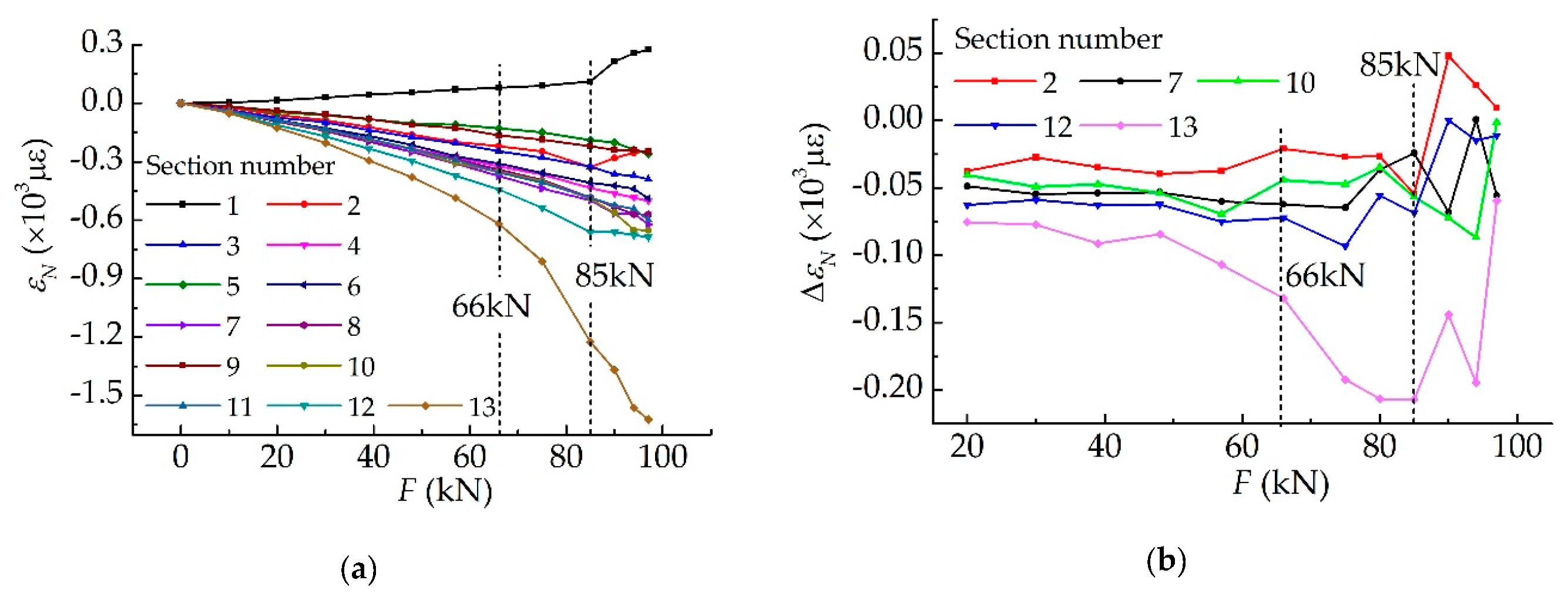
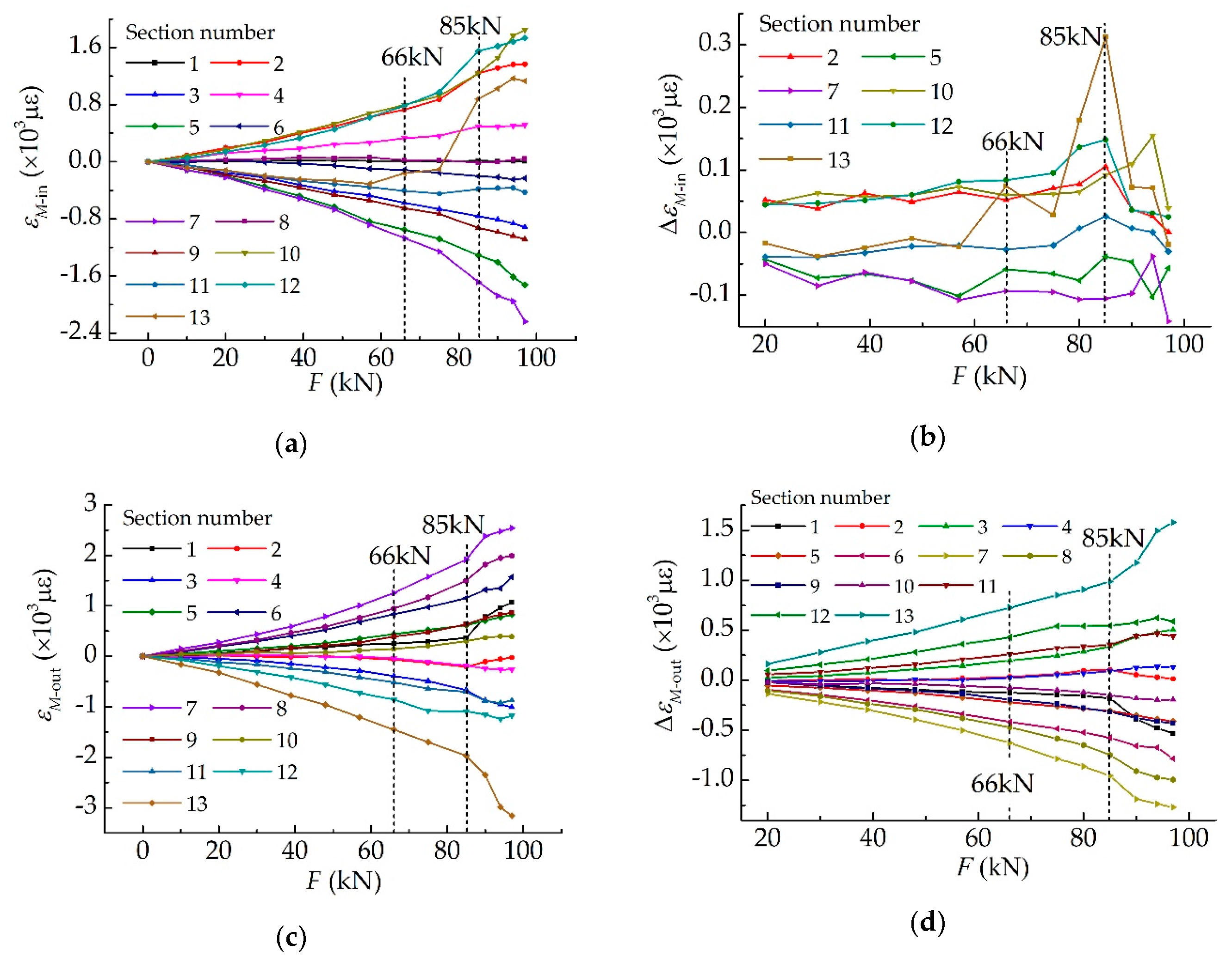


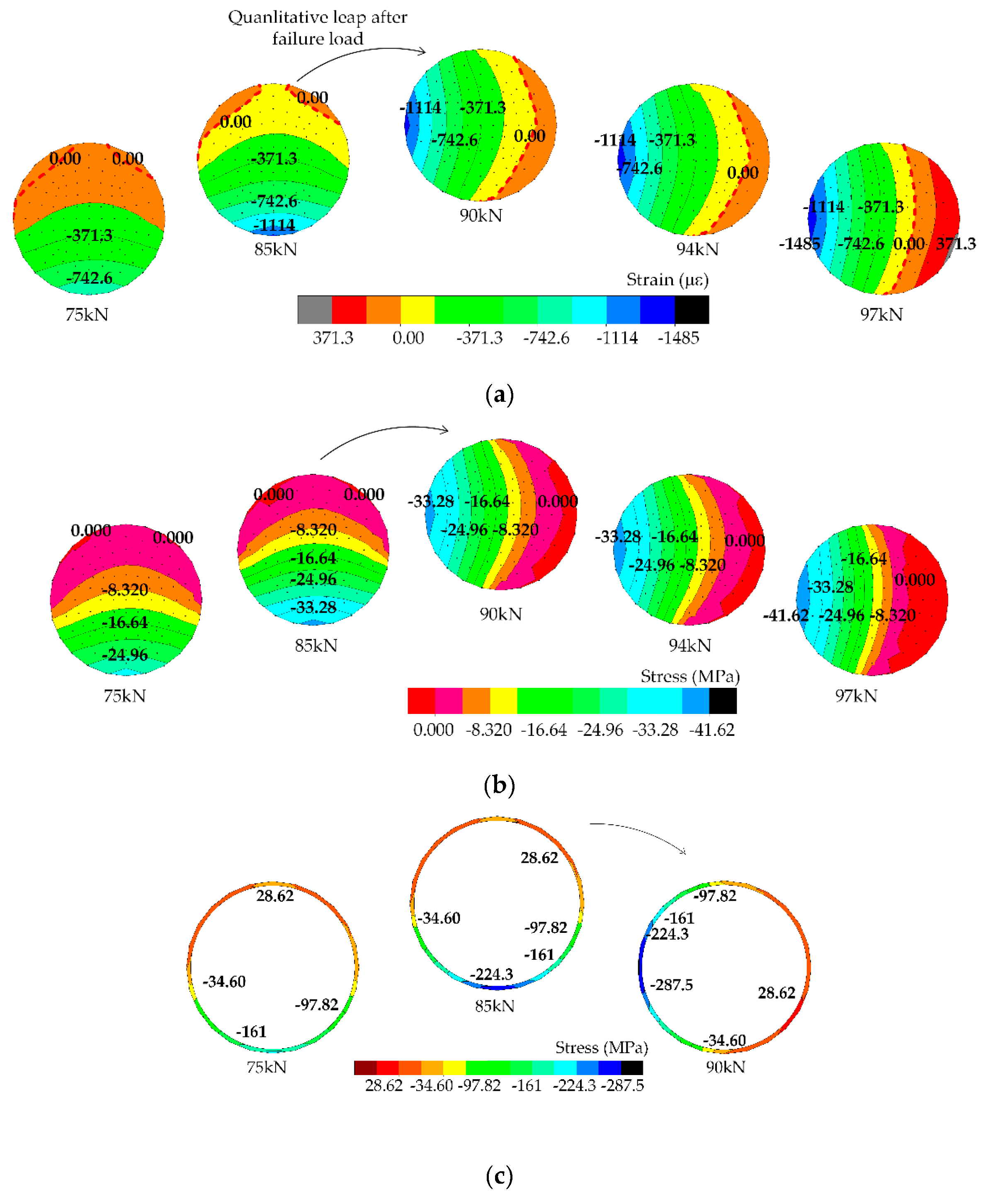
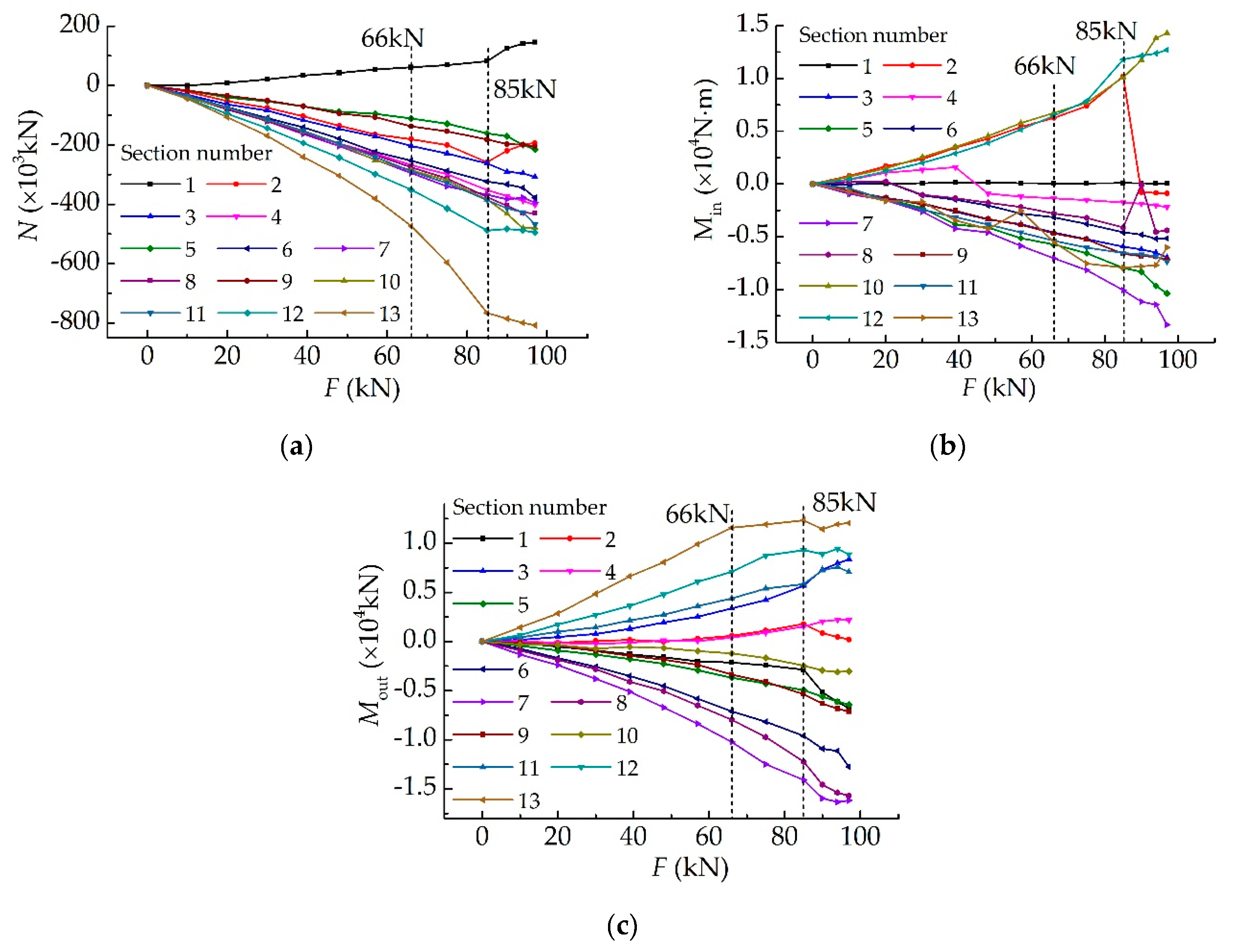
© 2019 by the authors. Licensee MDPI, Basel, Switzerland. This article is an open access article distributed under the terms and conditions of the Creative Commons Attribution (CC BY) license (http://creativecommons.org/licenses/by/4.0/).
Share and Cite
Yang, K.; Yuan, J.; Shi, J.; Zheng, K.; Shen, J. Stressing State Analysis on a Single Tube CFST Arch Under Spatial Loads. Appl. Sci. 2019, 9, 5039. https://doi.org/10.3390/app9235039
Yang K, Yuan J, Shi J, Zheng K, Shen J. Stressing State Analysis on a Single Tube CFST Arch Under Spatial Loads. Applied Sciences. 2019; 9(23):5039. https://doi.org/10.3390/app9235039
Chicago/Turabian StyleYang, Kangkang, Jian Yuan, Jun Shi, Kaikai Zheng, and Jiyang Shen. 2019. "Stressing State Analysis on a Single Tube CFST Arch Under Spatial Loads" Applied Sciences 9, no. 23: 5039. https://doi.org/10.3390/app9235039
APA StyleYang, K., Yuan, J., Shi, J., Zheng, K., & Shen, J. (2019). Stressing State Analysis on a Single Tube CFST Arch Under Spatial Loads. Applied Sciences, 9(23), 5039. https://doi.org/10.3390/app9235039



